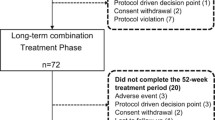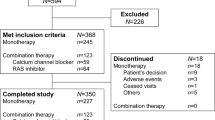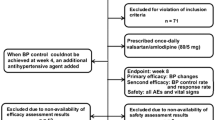Summary
In order to assess the effective dose, tolerability, and safety of isradipine as a monotherapeutic antihypertensive agent for Chinese patients in Taiwan, an open trial was carried out. This study consisted of a 2-week, placebo, run-in period and an 8-week active treatment period, starting with isradipine 1.25 mg twice daily (bid) for the first 4 weeks, followed by 2.5 mg bid if the blood pressure was not normalized (diastole <90 mmHg). One hundred and one patients (M/F=48:53) were valid for efficacy analysis. Their age ranged from 30 to 64 years (mean±SD, 52±8). The blood pressure before active treatment was 160±2/104±1 mmHg. At the end of treatment period I (week 4), 12–14 hours after the last dose, 38 (37.6%) patients were normalized and 47 (46.5%) subjects responded (diastolic blood pressure reduction ≥10 mmHg). At week 8, 68 (67.3%) patients were normalized and 79 (78.2%) subjects responded. Isradipine reduced both systolic and diastolic blood pressures within 2 weeks of treatment. There were no significant differences in blood pressure reduction between both genders and among age groups. Safety analysis showed two subjects with severe flushing, dizziness, and palpitation who used the dose of 1.25 mg bid. They withdrew from the study. The adverse reactions of other patients were transient, mild, and tolerable. Most of the side effects were related to vasodilatation, but edema was not found. There was no change in body weight or heart rate, nor any atrioventricular conduction disturbances. In conclusion, isradipine in a dose of 1.25 or 2.5 mg bid proved to be an effective and well-tolerated antihypertensive agent for Chinese subjects in Taiwan with mild to moderate essential hypertension. This finding is similar to those reported in Caucasian patients.
Similar content being viewed by others
References
Weinberger MH. Can essential hypertension be subclassified with respect to mechanisms?Hypertension 1991;18(Suppl I):182–186.
Bianchi G, Ferrari P, Barber BR. Lessons from experimental genetic hypertension. In: Laragh JH, Brenner BM, eds.Hypertension. New York: Raven Press, 1990:901–922.
Ruegg UT, Hof RP. Pharmacology of the calcium antagonist isradipine.Drugs 1990;40(Suppl 2):3–9.
Fitton A, Benfield P. Isradipine. A review of its pharmacodynamic and pharmacokinetic properties, and therapeutic use in cardiovascular diseases.Drugs 1990;40:31–74.
De Keyser P, Bouve J, Clement D, et al. Isradipine in essential hypertension: The Belgian general practitioners' study.Am J Med 1989;86(Suppl 4A):103–109.
Sundstedt CD, Ruegg PC, Keller A, et al. A multicenter evaluation of the safety, tolerability, and efficacy of isradipine in the treatment of essential hypertension.Am J Med 1989;86(Suppl 4A):98–102.
Miller H. Isradipine: Overall clinical experience in hypertension in the United States.J Cardiovasc Pharmacol 1990;15(Suppl 1):S60-S64.
Winer N, Thys-Jacobs S, Kumer R, et al. Evaluation of isradipine (PN200–110) in mild to moderate hypertension.Clin Pharmacol Ther 1987;42:442–448.
Hasson L. Isradipine in hypertension.Drugs 1990;40(Suppl 2):10–14.
Kirch W, Burger KJ, Weidinger G, et al. Efficacy and tolerability of the new calcium antagonist isradipine in essential hypertension.J Cardiovasc Pharmacol 1990;15(Suppl 1):S55-S59.
Zhou HH, Koshakji RP, Silberstein DJ, et al. Racial differences in drug response. Altered sensitivity to and clearance of propranolol in men of Chinese descent as compared with American whites.N Engl J Med 1989;320:565–570.
Griebenow R, Kaufmann W, Kramer L, et al. Isradipine: a new calcium antagonist with strong vasodilatory but negligible cardiodepressive effects.J Cardiovasc Pharmacol 1990;15(Suppl 1):S84-S86.
Cummings DM, Amadio P Jr, Nelson L, et al. The role of calcium channel blockers in the treatment of essential hypertension.Arch Intern Med 1991;151:250–259.
Sauter A, Rudin M. Treatment of hypertension with isradipine reduces the infarct size following stroke in experimental animals.Am J Med 1989;86(Suppl 4A):130–133.
McGrath BP, Newman R, Older P. Hemodynamic study of short-and long-term isradipine treatment in patients with chronic ischemic congestive heart failure.Am J Med 1989;86(Suppl 4A):75–80.
van Wijk LM, van Gelder I, Crijns HJ, et al. Cardiac electrophysiologic properties of intravenous isradipine in patients with sick sinus syndrome.Am J Med 1989;86(Suppl 4A):88–90.
Hamilton BP. Treatment of essential hypertension with PN 200–110 (isradipine).Am J Cardiol 1987;59:141B-145B.
Kirkendall WM. Comparative assessment of first-line agents for treatment of hypertension.Am J Med 1988;84(Suppl 3B):32–41.
Brater DC. Pharmacodynamic consideration in the use of diuretics.Annu Rev Pharmacol Toxicol 1983;23:45–62.
Buhler F, Kiowski W: Age and antihypertensive response to calcium antagonists.J Hypertens 1987;5(Suppl 4):111–114.
Chobanian AV: Treatment of the elderly hypertensive patient.Am J Med 1984;77:22–27.
Hof RP. Comparison of vasodilator and cardiodepressant effects of PN200–110 (isradipine), nifidipine and diltiazem in anesthetized rabbits.Am J Cardiol 1987;59:37B-42B.
Weinstein DB, Heider JG. Antiatherogenic properties of calcium antagonists.Am J Cardiol 1987;59(Suppl B):163–172.
Grimm RH Jr, Flack JM, Byington R, et al. A comparison of antihypertensive drug effects on the progression of extracranial carotid atherosclerosis. The Multicenter Isradipine Diuretic Atherosclerosis Study (MIDAS).Drugs 1990;40(Suppl 2):38–43.
Woo J, Chan TYK, Critchley JAJH. A clinical evaluation of the efficacy and tolerability of isradipine in the treatment of hypertension in a Chinese population.Adv Ther 1990;7:362–368.
Welzel D, Burger KJ. The calcium antagonist isradipine in the therapy of hypertension. A double-blind crossover comparison with nifedipine.Drugs 1990;40(Suppl 2):60–64.
Author information
Authors and Affiliations
Rights and permissions
About this article
Cite this article
Chen, MF., Chen, CC., Chen, WJ. et al. Dose titration study of isradipine in Chinese patients with mild to moderate essential hypertension. Cardiovasc Drug Ther 7, 133–138 (1993). https://doi.org/10.1007/BF00878322
Received:
Accepted:
Issue Date:
DOI: https://doi.org/10.1007/BF00878322




